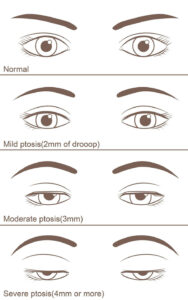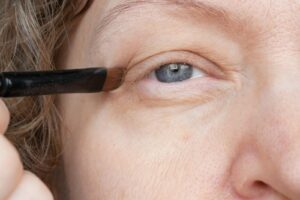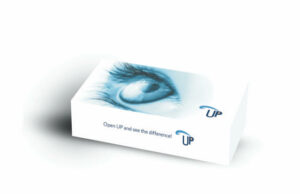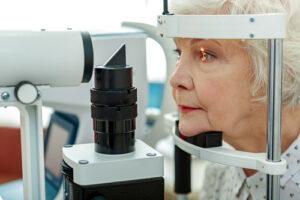Do your eyelids look droopy or saggy? It may seem frustrating, but it’s much more common and likely to occur due to getting older.
With age, the muscles in the body can weaken, including those in your face. Weak muscles around the eye can lead to drooping eyelids.
Having eyelids that look droopy can make you feel self-conscious about your appearance. More importantly, though, it can also make it harder to see.
There are ways to correct drooping eyelids surgically, but there’s also a new, non-invasive treatment option called Upneeq. Upneeq can be used to treat a specific cause for drooping eyelids called acquired ptosis.
Here at See Clearly Vision, we are now offering this revolutionary new ptosis treatment option to our patients that qualify and are a good fit for it. Keep reading to learn more about what acquired ptosis is and how to treat it using Upneeq!

What is Acquired Ptosis?
Acquired ptosis, which is short for acquired blepharoptosis, is a condition that develops when the upper eyelids begin to droop or sag. This drooping happens when the muscles or nerves that hold the eyelids in place weaken.
The most common reason the muscles around the eye weaken is due to aging and getting older. But acquired ptosis can also happen for other reasons, including neurological or nerve conditions, masses on the eyelid, multiple sclerosis (MS), and diabetes.
Having droopy or sagging eyelids can affect your appearance, making you look tired. This can affect your self-confidence and make you feel older.
Sagging eyelids also can make it harder to see by blocking part of your vision. Both of these effects are reasons that acquired ptosis should be diagnosed and treated.
Acquired Ptosis Diagnosis and Treatment
If your eyelids are drooping, the first thing you should do is see your eye doctor. Your eye doctor can diagnose acquired ptosis and recommend treatment.

There are a few kinds of treatment options available for this form of ptosis, but most are surgical procedures. But for patients that don’t want to undergo surgery, or don’t have as severe a case of acquired ptosis, a non-invasive form of treatment like Upneeq may be the perfect solution.
What is Upneeq?

Upneeq is a medication that’s used to treat acquired ptosis. It comes in the form of eye drops.
Using the Upneeq eye drops daily gradually lifts your eyelids, allowing you to see better and improve your appearance. Upneeq is made from an oxymetazoline hydrochloride ophthalmic solution.
In a different form, the solution can also treat minor eye irritations. But when used regularly, using Upneeq eye drops can help patients who have acquired ptosis.
How Does Upneeq Work?
Upneeq is made from an eye decongestant. The solution works by constricting the blood vessels in the eye.
This effect is good for treating eye redness, but medical professionals have discovered that you can also use it to improve the symptoms of acquired ptosis. The continued impact of using the solution regularly has been proven to cause eyelids to droop less, providing patients with an improved appearance and increased range of vision.

Many patients report immediate improvement after taking their very first dose, with the effects only getting better over time. Over 85% of patients saw an improvement in the droopiness of their eyelids when taking Upneeq.
How Do You Use Upneeq?
Using Upneeq is simple. Patients take the drops daily, administering one eye drop per eye. The drops are conveniently portioned into single-use containers.
You’ll never need to worry about if you’re using the right amount, instead always having the exact amount right when you need it. If you wear contact lenses, you can use Upneeq as long as you wait 15 minutes after administering the eye drops to put in your contacts.
Is Upneeq Right for You?
If you have acquired ptosis, the chances are good that you can benefit from taking Upneeq. Before you do anything else, though, you need to talk to your eye doctor, as Upneeq may not be suitable for everyone.
Using Upneeq may cause issues if you have a pre-existing eye condition like glaucoma. You should also keep in mind that Upneeq does have a small risk of elevating your blood pressure since it constricts the blood vessels in your eye. You’ll want to keep this in mind as something of concern if you’re at risk for high blood pressure or you have high blood pressure.
This effect is minor and harmless for most patients, but it may be unsafe if you use another medication that can affect your blood pressure or if you have hypertension. This is why it’s also not a good fit for patients with glaucoma or patients at high risk for glaucoma due to high blood pressure.

Before you’re prescribed Upneeq, your eye doctor at See Clearly Vision will perform a comprehensive eye exam. They’ll also want to go over your medical records.
These precautions are the safest way to ensure that Upneeq is the correct medication for you. If certain neurological disorders, including stroke, cause your acquired ptosis, Upneeq may not be safe for you.
Certain medications can also react poorly when taken with Upneeq. But as long as you disclose your medical information to your eye doctor and discuss the potential for complications before taking Upneeq, the risks involved with this treatment option are minimal.
Because eye drops are less invasive than undergoing a surgical procedure, it may be beneficial to try Upneeq before considering more invasive treatment options. Although there is the potential for side effects, using Upneeq eye drops is easy, has minimal side effects, and can vastly improve your condition while helping you feel better about your appearance.
Learn more about Upneeq and if it may be right for you by scheduling an appointment at See Clearly Vision at one of our convenient locations in Tyson’s Corner and Arlington, VA!



















